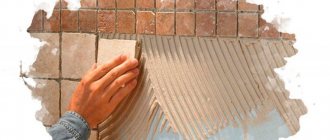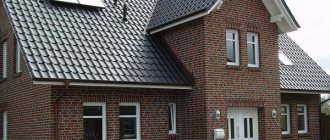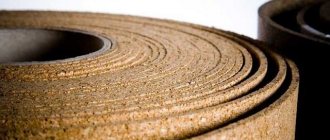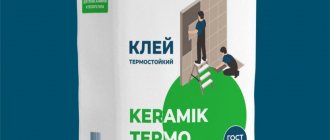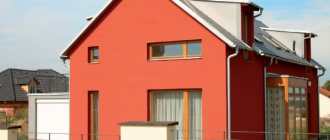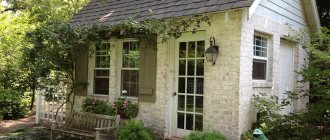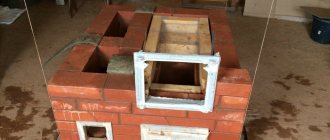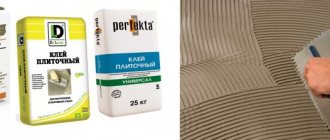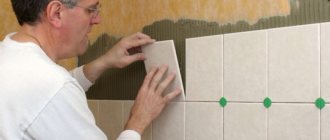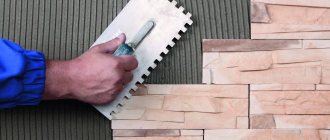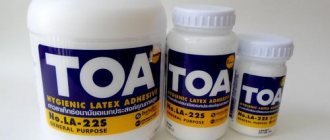All your efforts to select the right floor tiles may be ineffective if you do not install them with the right adhesive. Picking it up is not as easy as it might seem. Various binder mixtures, presented on the market by many manufacturers, are usually intended for certain types of tiles.
The most difficult thing is to choose an adhesive composition for a heavy coating. To ensure reliable bonding, increased adhesion to the surface is necessary. Such qualities are not typical for every glue. One of the best options for a binder mixture is Flizen Knauf tile adhesive.
Application area
Fliesen glue is produced by the German company Knauf. This is a loose building mixture that, after dilution, turns into a solution for laying tiles, porcelain stoneware, clinker, tile blocks and mosaics.
The composition is suitable for tiles of any shape, but it is best used with the following materials:
- tiles 300x300 mm with moisture absorption more than 3%;
- porcelain stoneware 600x600 mm;
- any ceramic floor covering.
Knauf adhesive has proven itself well when attaching bases made of polystyrene, foam plastic, glass wool, polyurethane, and when installing glass-magnesium sheets. Due to the high adhesive parameters, they are used to glue finishing and insulating materials to concrete, cement, silicate surfaces and brickwork, and to plasterboard. Fliesen is used for gluing tongue-and-groove slabs.
Due to its resistance to temperature changes, the adhesive composition is used when laying heated floors and other heated structures. Fliesen is used for gluing external and internal cladding.
Features of the Knauf Fliesen adhesive composition
The German manufacturer Knauf produces ready-made dry mixture Knauf Fliesen, which, after dilution, creates a high-quality glue. This solution is intended for tile panels of any size, as well as for clinker blocks, mosaics and porcelain stoneware.
Experts recommend choosing this material for laying tiles with sides of 30 x 30 cm, the level of water absorption of which is more than 3%. It is also used for floor porcelain stoneware and other elements with dimensions of 60x60 cm.
Specifications
| Characteristic | Meaning |
| Level of adhesion to concrete base, MPa | 0,6 |
| Operating temperature | +5…+25 |
| t °C operation | -45…+80 |
| Drying time before grouting, days | 1 |
| Drying time before use, days | 2 |
| Time for complete drying before applying high mechanical loads, days | 7 |
| Viability of the mixture, h. | 2,5 |
| Time period during which the tile position can be adjusted, min. | 10 |
| Thickness of the adhesive seam, cm | 0,2-0,6 |
| Frost resistance, freeze/defrost cycles | up to 50 |
| Moisture absorption coefficient, % | No more than 3 |
| Expiration date, year | 1 year in undamaged original packaging in compliance with the manufacturer's requirements |
Properties
- The thick consistency of the mixture allows you to fasten heavy slabs, blocks, and stone elements. To ensure good adhesion, you must strictly follow the instructions and not violate the temperature regime during operation.
- Knauf Fliesen has a short adjustment period, so it needs to be applied to small surface areas. If you glue the tiles onto a dried mortar, the adhesive characteristics will be significantly reduced.
- The glue is elastic, it is easy to process surfaces with small defects and pits. Thanks to its plastic structure, the adhesive seam does not collapse over time. Suitable for use on terraces, street steps, balconies and verandas.
- The glue is resistant to moisture, so it can be used for laying cladding in the kitchen, bathrooms, dressing rooms, etc. Waterproofing of moisture-absorbing substrates is carried out on a mineral basis, and additionally provides protection against mold, microbes, and fungi.
A beginner without any experience in construction work can prepare the solution; it is enough to follow all the instructions on the packaging. In order for the finished solution to have a sufficient level of adhesion, the proportions recommended by the manufacturer are strictly adhered to.
What materials is it suitable for?
Features of the composition guarantee increased adhesion of Knauf Fliesen glue to finishing surfaces and fixation of thermal insulation of other materials from:
- Decorative elements made of polyurethane;
- Foamed polystyrene insulation;
- Heat and sound insulation made of glass wool;
- Magnesium glass panels.
It is also suitable for laying tiles on the screed of a water or electrical heated floor.
Advantages
- Can be used with a variety of substrates and combines well with insulating materials.
- Various types of tiles and mosaics are glued. Due to the gray color it is not recommended for clear or glass cladding.
- A non-professional can work with the composition; to prepare it, it is enough to accurately follow all the instructions.
- Low fluidity allows Flizen to be used for gluing cladding to vertical structures.
- The mixture levels surfaces with height differences of up to 0.2 cm, due to which the number of repairs is significantly reduced.
- Forms a monolithic surface, correcting it, hiding microcracks in the screed.
- The adhesive joint has a long service life; the tiles will last a long time on any surfaces in heated, unheated rooms and outdoors.
- The seam is not affected by intense, dynamic loads, it does not deteriorate or collapse.
- The finished mixture is very plastic, which is why there is no need to soak the tiles before gluing.
- Sold in convenient packaging. Packaged in packs of 25 kg. The price is affordable, unlike analogues from other manufacturers.
Types and forms of release
Knauf adhesives differ in layer thickness and caliber of facing material with which they work. All types are packaged in durable paper bags with several protective layers of 10, 25 kg.
It is recommended to store packages on wooden pallets in rooms protected from moisture.
Universal glue
Knauf Fliesenkleber presents a universal composition for interior work on gluing tiles with water absorption up to 3%. It can be used for external cladding, but the water absorption rate of the tile must be above 5%.
Fliesenkleber adheres well to concrete, plaster, cement-sand bases and plasterboard.
Not used for gluing low-porosity tiles, which have a low water absorption coefficient.
Flizen Flex
Knauf Fliesen Flex tile adhesive has increased elasticity and ductility. Effective when working with porous, medium-porous tiles, stone tiles and porcelain stoneware. Adheses well to any substrate, including insulating materials. Knauf Flex can withstand significant dynamic loads. They are used to cover surfaces made of wood, chipboard, and install heated floors.
Flizen Plus (reinforced)
The composition of Knauf Fliesen Plus is supplemented with mineral fillers and polymers that enhance the strength of the seam. It has good adhesion to concrete and cement bases; tiles are glued to drywall.
The reinforced composition is not afraid of low temperatures, therefore it is used in finishing work on the facades and plinths of buildings. It is used to glue materials with low water absorption, including not only tiles, but also various types of stone.
Fliesen Marble
Knauf Marble is based on minerals, polymers and white cement, which is why its color is white. They can be used to glue natural and artificial stone, granite, porcelain tiles, mosaics, ceramics, and glass tiles. Has a high level of adhesion. When gluing large-sized Fliesen elements, Marble is applied to the base and the reverse side of the material.
Comparison with other analogues of the line
Tile adhesives from Knauf differ in the additives they contain. They are responsible for the properties of the glue and its purpose.
- To install heated floors, only those mixtures are used that are not afraid of temperature changes, for example, Flizen Flex. It is optimal for laying industrial floors and surfaces subject to dynamic loads.
- The universal Knauf Flizen is rarely used for gluing porcelain tiles; it is more often used when installing regular tiles.
- Fliesen Marble is used when working with decorative or artistic tiles.
- Knauf Flizen Max is applied in a layer of up to 3 cm, it helps to strengthen the strength of the masonry, levels the floor and walls, and is used on surfaces with large differences in height, but it cannot be used to attach cladding to a warm floor.
- Flizen Plus is used to glue low-porosity porcelain tiles.
An analogue from other manufacturers is CERESIT SM-11 tile adhesive.
Price Knauf Fliesen
| Name | Bag volume, kg | Price, rub |
| Fliesen | 25 | ~235 |
| Flizen Plus | 25 | ~300 |
| Fliesen Max | 25 | ~290 |
| Flex | 25 | ~550 |
| Fliesen Marble | 25 | ~495 |
The price depends on the seller and the country's currency. The table shows the cost of glue from Yandex Market.
Consumption
| Tile size, cm | Spatula tooth height, cm | Tile adhesive consumption per 1m2, kg/m. sq. |
| Less than 10 | 0,4 | 1,7 |
| 10-20 | 0,6 | 2,2 |
| More than 20 | 0,8 | 2,9 |
The table shows the size of the trowel tooth when the tile has a smooth back side. If the tile backing is embossed, the tool should have higher teeth.
Consumption of different brands:
- Fliesen - 2.2-2.9 kg/m. sq.;
- Fliesen Plus – 1.7-2.7 kg/m. sq.
To calculate the number of bags, the formula is used: N=(S*L*H)/2,
- where N is the number of bags;
- S – area of the surface to be pasted;
- L – spatula tooth height;
- H – basic material consumption.
Let's say tiles are laid on the floor in a room with an area of 20 square meters, while the base mixture consumption is 2.2 kg/m. sq. The glue is packaged in bags of 25 kg, and the height of the spatula teeth is 0.6 cm.
(20*2.2*6)/2=132 kg or approximately 6 bags of dry glue.
How to store
Tile adhesive should be stored only in dry, ventilated areas. The bags must be placed on wooden pallets or other devices, and the shelf life of the adhesive composition in intact packages does not exceed 1 year from the date of production. If the bag has been damaged, it must be used first.
Dilution of the mixture
Dry powder is mixed with water strictly in proportion. 250-300 ml of water is added to 1 kg of bulk mixture. A 25 kg paper bag requires 7-7.5 liters of water.
Water is poured into the container, the powder is poured out, and the resulting composition is thoroughly mixed with a construction mixer or a drill with an attachment. You need to stir until the solution in the container becomes homogeneous without lumps. Afterwards, the container is covered with a lid. After 5 min. When idle, the mixture is mixed again and is completely ready for use.
The prepared solution does not lose its properties for 2.5 hours. During this time, it is necessary to have time to work out the entire volume and only then begin a new batch.
If the mixture has thickened a little, you can mix it with a mixer, but diluting it with water is not recommended.
Surface preparation
The compliance of the ambient temperature with the optimal temperature regime specified in the instructions is checked. In hot weather, the glue dries quickly, and at temperatures below +5 °C it thickens or freezes.
- The base is cleaned of dust and dirt.
- The form lubricant is wiped off the concrete surface.
- The base is degreased with household chemicals or solvents.
- The old finish is removed.
- Water-based emulsion or any paint that is not resistant to water is washed off, water-resistant paints and varnishes are sanded off.
- The surface is dried; wet substrates cannot be coated with tile mixture.
- When installing a heated floor, it is disconnected from the power supply one day before the start of preparatory work.
- The gypsum screed and areas exposed to water are covered with waterproofing.
- If the thickness of the plaster on the base exceeds 1 cm, the excess is removed.
- Strongly absorbent substrates are primed. It is better to use soil from the same manufacturer.
For highly porous surfaces - Knauf Grundirmittel, for moderately porous - KNAUF Tiefengrund.
Applying glue
The finished mixture is collected from the container with a trowel. The glue is transferred to the smooth side of the spatula and distributed evenly over the base.
Afterwards, the toothed part of the tool is passed along the applied adhesive layer. For good adhesion, the glue should remain on 80% of the base. The amount of composition is determined as follows: the glued tile is removed, the master examines the back side and visually assesses the volume of glue remaining on it. If there is not enough mixture, you need to replace the spatula with a tool with larger teeth. You can also additionally apply glue to the underside of the facing material.
When carrying out external work, Knauf Fliesen is applied both to the base and to the back side of the tile.
After gluing the tile, its position can be changed for another 10 minutes. If it is laid correctly, it is firmly pressed against the base for better fixation. The evenness of the installation is controlled by a level or level. When a dense film appears on the applied solution, it is removed manually, and a new layer is applied in its place. If the composition gets on the front side of the tile, it can be easily removed with a damp cloth.
To ensure that the gaps between the tiles are equal, plastic crosses or clips are used, which are removed after a day. The voids between the laid tiles are filled with grout, and its residues, after drying, are wiped off with a dry sponge. The grout is applied only after the tile adhesive has completely hardened.
Usage
Before laying tiles or other facing materials, it is necessary to properly prepare the base. This involves not only removing the crumbling old coating. It is necessary to remove any dirt and oil stains, and get rid of lime if there is any on the floor surfaces.
Next, a deep penetration primer is applied to the ceiling. It will strengthen the base, level its structure, and bind remaining dust particles and microcracks. After applying the primer, the surface is leveled with a cement-based rough plaster mixture, then trimmed and treated again with a primer. And only after this can cladding be carried out.
The glue is diluted with clean water at room temperature according to the instructions indicated on the bag label. In this case, a construction mixer is used so that the working solution has a uniform consistency. After the initial stirring, it is left for a few minutes, then mixed again and used. During the work, use a regular spatula to apply glue to the work surface, as well as a serrated tool to normalize the amount of glue.
Apply glue to part of the surface, distribute it evenly, then remove the excess using a notched trowel. Take a die, spread glue on it, and then pass through the solution with a notched trowel in a direction perpendicular to that on the plane. This way you will be able to distribute the glue correctly and also carry out the work as carefully as possible. Afterwards the element is slightly pressed to the base.
This is how all the dies are laid. To identify the gaps between the tiles, plastic crosses or special clamps are used. Excess composition is removed with a rag. You cannot scratch it from tiles or other materials, as this will affect the aesthetics of the cladding.
A day after installation, the crosses or clamps are removed, and the voids between the fragments are filled with a special grouting compound. After it has dried and hardened, the remaining grout is removed with a dry sponge, rubbing it over the entire facing area. You can treat the surface with a special spray. Do not grout if the tile adhesive has not yet dried.
Recommendations
- As the ambient temperature rises, the time spent working with the mixture decreases.
- During operation, avoid drafts and direct sunlight.
- In damp rooms, the working time with the composition increases.
- The mixture must not be diluted with any liquids other than water.
- For exterior work or when gluing large areas, it is recommended to provide expansion joints.
- After work, the entire instrument is washed with water before the solution hardens.
- All work with tile adhesive is carried out wearing protective equipment.
Flaws
- If you do not prepare the base before gluing or violate the temperature conditions for working with the composition, its adhesion will deteriorate.
- The glue has a fairly short correction time. Beginners sometimes find it difficult to complete in 10 minutes. install the facing coating correctly and use the entire prepared composition.
